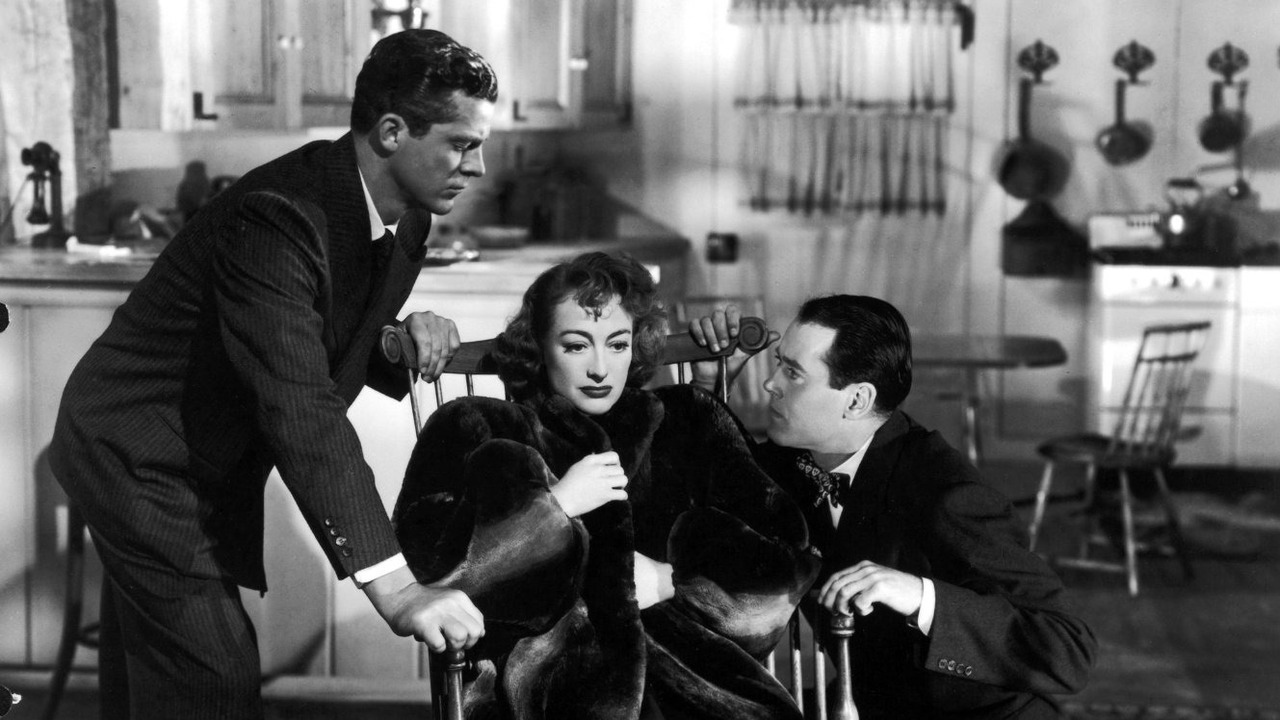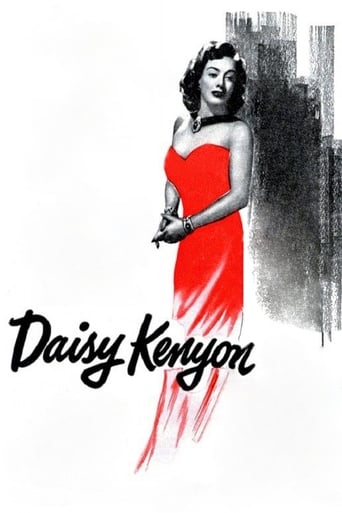Lollivan
It's the kind of movie you'll want to see a second time with someone who hasn't seen it yet, to remember what it was like to watch it for the first time.
Humaira Grant
It’s not bad or unwatchable but despite the amplitude of the spectacle, the end result is underwhelming.
Brennan Camacho
Mostly, the movie is committed to the value of a good time.
Fatma Suarez
The movie's neither hopeful in contrived ways, nor hopeless in different contrived ways. Somehow it manages to be wonderful
utgard14
Joan Crawford soaper, directed by Otto Preminger, with a familiar plot of Joan being torn between two men (married lawyer Dana Andrews and returning soldier Henry Fonda). Joan made these sorts of love triangle melodramas all the time in the 1930s. Despite the hackneyed romance, this is actually a pretty interesting film. For one thing, it has more of a noirish look than those earlier Joan melodramas. For another, it deals with some pretty adult material for a movie of its time, like child abuse, divorce, and even an easy-to-overlook bit about a civil rights case where a Japanese-American soldier had his farm taken from him while he was fighting in the war. Finally, it's well-acted all around and each of the stars gets some good material to work with. Yeah, Joan's style from this period (shoulder pads, heavy eyebrows, and general masculine femininity) can be a little distracting at times, but Preminger does a good job of making the rest of the picture so attractive you are able to look past that. It's worth a look if you are a fan of the three stars or the director, but it isn't the best any of them have done.
kidboots
In ten years Joan Crawford went from being "box office poison" to winning an Oscar for "Mildred Pierce" to almost winning again for "Possessed" - most critics felt she should have won but Loretta Young did for "The Farmer's Daughter". Both director, Otto Preminger, and star, Henry Fonda, wished to forget "Daisy Kenyon" later in their careers and it was a film that opted for mushy romance over psychological drama, elements it had in abundance.Commercial artist Daisy Kenyon (Crawford) is being given the runaround by her married lover Dan (Dana Andrews). Initially he comes across as a brash charmer juggling mistress and family but in reality his wife is a neurotic who takes her frustrations out by abusing younger daughter Marie (Connie Marshall)!!! But Daisy is getting fed up with always coming second and the endless waiting by the telephone, so when she meets Peter (Fonda) who impulsively asks her to marry him she says yes.This movie could have gone in so many directions rather than down the road to romance. There was the child abuse angle - Marie was always a bundle of nerves at the thought of being left with her mother and even turns up at court with a bandaged ear but Dan seems oblivious to everything but his own happiness. At the end he even indicates that both mother and daughter would get used to each other in time but he had to be free!! Again, another sequence shows him accepting a brief (he was a lawyer of course) that dealt with a Japanese man who had won the Purple Heart but returned to find his home had been seized. Dan was told accepting this case would make him feel more worthwhile and not just a society lawyer. He takes the case and loses but you only hear about it, by this time the movie is really the Daisy and Dan story!! Oh, and Peter has some psychological problems stemming from the death of his first wife. He often wakes up at night with horrible nightmares. His problems, too, are miraculously righted and the end of the movie shows the three of them snowed in at a mountain cabin where Peter and Dan, like in a court case, put forward their cases as to why they are the best person for Daisy.Peter Fonda comes off best (probably because he is a better actor than Dana Andrews) but his pacing and demeanor are so dreamlike, it was almost as though he was in a different movie - he probably wished he was!!
Michael O'Keefe
The revered Otto Preminger directs three well healed actors, Joan Crawford, Dana Andrews and Henry Fonda. This drama features Crawford as Daisy Kenyon, a Manhattan commercial artist that is being squired by Dan O'Mara(Andrews), a high dollar lawyer, married with kids. Daisy has had O'Mara on the string long enough and she expects hims to divorce his wife Lucille(Ruth Warrick). The attorney pussy foots the idea and just can't bring himself to do it. Meanwhile Daisy is also keeping company with an army sergeant Peter Lapham(Fonda) actually hoping to make Dan jealous. Both men argue over her, but when she nearly kills herself in an auto accident Daisy realizes she truly loves Lapham. By this time Lucille has overheard a phone call made by her husband professing his love for Daisy...divorce proceedings will soon be underway. Two men on a string, but does she even deserve either one? Making cameo appearances at New York's fabled Stork Club are John Garfield, Walter Winchell and Leonard Lyons. Other players include: Roy Roberts, Victoria Horne, Connie Marshall and Martha Stewart. Soap opera on the big screen.
blanche-2
Joan Crawford is "Daisy Kenyon" in this 1947 film about a woman torn between two men - one, a married, successful man (Dana Andrews), and the other, a returning soldier and widower (Henry Fonda). Directed by Otto Preminger, it's a good noir, better than "Dark Angel" but nowhere near "Laura." Andrews is married to Ruth Warrick and has two daughters who need him, as their mother, when unhappy, tends to be abusive. He has a long-time relationship with Daisy, who is a successful commercial artist. The situation isn't ideal for her, but she's in love. One night she meets a soldier who wants to build a life with her. Can she break from Andrews - and will he let her? There are several striking things about this film. One is the casting. In order to play the lead in "Grapes of Wrath" in 1940, Darryl Zanuck forced Henry Fonda to sign a 7-year-contract, for which Fonda never forgave him. One can see an example of why here. In this film, he has to share leading man duties with Dana Andrews in what is, in fact, a Joan Crawford movie. To me, Fonda's role in this seems very inauspicious and one where a lesser star could have been cast. Just an opinion. He's excellent as a lonely, unhappy man who falls for Daisy - Fonda at this point still had some traces of boyishness.The second striking thing for me was the subtlety of the acting. There is a scene in which Dana Andrews, returning from an 18-day-trip, can't get the usually reliable Daisy on the phone, so he goes to see her. It's a scene that should be shown in acting schools - full of atmosphere and subtext, so little is said in dialogue; so much is what lies beneath the surface. Both Crawford and Andrews give wonderful performances.The third striking thing is the Greenwich Theater, which I had no idea was torn down until now. There was indeed a restaurant across from it, too. That's also my old neighborhood, and it was a delight to see. I believe I went to the opening day of "Fargo" there.Throughout the film, the symbolism of a New York cab is used: if you were staying where you were, you let the cab go; if not, you asked it to wait. The theme reinforces the ending of "Daisy Kenyon" very well. A good movie.

